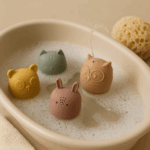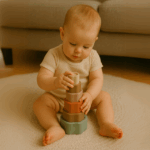Montessori toys have taken the world of education by storm with their focus on child-centred, experiential learning. Within this rich spectrum of educational approaches, silicone toys have taken a prominent place. In this article, we dive deeper into the world of Montessori toys, with a particular focus on the innovative use of silicone materials.
The Essence of Montessori Toys
Montessori education, developed by Dr Maria Montessori, emphasises children's intrinsic curiosity and their natural desire for self-discovery. The principles of freedom within limits and respect for the child's autonomy form the backbone of this educational system. Montessori toys are designed to support this philosophy by creating an environment that invites self-directed learning and exploration.
Silicone Toys: A Modern Jewel within Montessori
Within the diverse range of Montessori toys, silicone toys occupy a prominent place. Silicone, a durable and safe material, has offered toy designers new opportunities to create creative, sensory and educational pieces that perfectly align with Montessori's core principles.
The Role of Silicone Toys within Montessori
Silicone toys offer a unique set of properties that make them particularly suitable for Montessori education, especially for children in their early developmental years.
Sensory Exploration and Tactile Experience
A notable feature of silicone toys is the rich sensory experience they offer. The material is soft and pleasant to the touch, making it the perfect playmate for children exploring their sense of touch. This not only promotes sensory development, but also encourages children to be aware of different textures and sensations in their environment.
Stimulation of Motor Skills
Montessori toys aim to stimulate children's fine motor skills and hand-eye coordination. Silicone toys, with their soft and flexible nature, make it easy for little hands to hold and manipulate. By grasping, stacking and sorting, children develop not only their motor skills, but also their concentration and patience.
Creative Challenges and Problem-Solving Thinking
Silicone Montessori toys are often designed with hidden challenges. It can consist of puzzle-like elements, connection points and stackable parts. These design elements challenge children to harness their creativity and develop problem-solving skills as they experiment and explore.
Sensory Stimulation and Language Skills Development
The use of vibrant colours and various shapes in silicone toys captures children's attention and stimulates not only their imagination, but also their language development. By sharing their discoveries and thoughts while interacting with the toys, children build their ability to communicate and learn.
Montessori Toys for 1-Year-Old Toddlers: A Special Journey of Discovery
1-year-old toddlers are at the beginning of a period of active exploration. Montessori toys for this age group, including silicone toys, play a crucial role in stimulating their development.
Safety and sustainability
Silicone toys are ideally suited for this age group because of their safety and durability. The material resists the teeth of curious toddlers and offers a soft texture that is easy to grasp. This contributes to a positive play experience and promotes the child's autonomy.
Tactile Exploration and Object Perception
For 1-year-old toddlers, the world is one big journey of discovery. Silicone toys with different textures invite them to explore their sense of touch and help them develop object perception. This lays the foundation for further cognitive development.
 Puzzles
Puzzles Water toys
Water toys Role-playing toys
Role-playing toys Sand toys
Sand toys